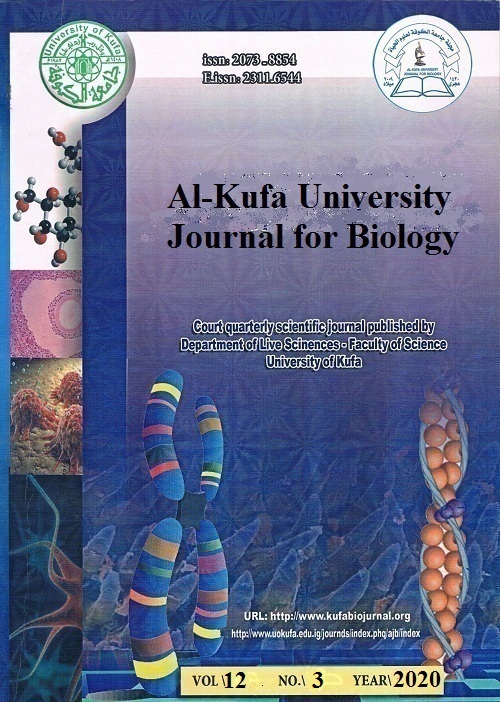Study of the effect of Cladophora crispate and Annona squamosa L.,alkaloids without or with albendazole on weights of mice infected with hydatid cysts
DOI:
https://doi.org/10.36320/ajb/v12.i3.11792Keywords:
Cladophora crispate, Annona squamosa. L., Hydatid cysts, AlbendazoleAbstract
The current study is aimed to test the incidence of infection at injection mice with protoscolices and evaluate the effectiveness of the effective compound derived from the algae Cladophora crispate and plant Annona squamosa L and compare it with albendazole at the infected with hydatid cysts.
The results of the current study show that there is a decrease in the average weight of infected mice and treatment with active substances alkaloids without or with albendazole compared to the positive control group as the effect of the mixed drug (algae , plant and albendazole) .Concentrate (0.6 mg / ml ) had given a therapeutic efficacy amount (82.35% ) and gave a percentage of cystic fibers ( 80.0 %) compared with the rest of the concentration the active ingredient drug.
This study found that the combination of both types of alkaloids algae Cladophora crispate and plant Annona squamosa L wih albendazole had the greatest effect in reducing weights of infected mice with hydatid cysts.
Downloads
References
Zhang, R ; Chen, X. and Wen, H. ( 2017). An improved experimental model of cystic hydatid disease in liver resembling natural infection route with stable growing dynamics and immune reaction . bioRxiv, 155168. DOI: https://doi.org/10.1101/155168
Pradhan, S., Dahal, R., Phuyal, S., & Ghimira, B., Singh, Y. (2017).Primary Hydatid Cyst of Pancreas. Retrieved from Case Report. Acta Scientific Medical Sciences., 101: 25-27.
Hayajneh, F. M. F., Althomali. A. M. H., & Nasr, A. T. (2014). Prevalence and characterization of hydatidosis in animals slaughtered at Al Taif abattoir, kingdom of Saudi Arabia. Open Journal of Animal Sciences, 4(10), 38. DOI: https://doi.org/10.4236/ojas.2014.41006
Polat, E. ; Aslan, M. ; Cakan, H. ; Saribas, S. ; Ipek, T. and kocazeybek, B. (2009). The effect of albendazole and povidone iodine for hydatid cysts protoscoleces , In vitro and vivo. Afri. J. Microbiol. 3(11) : 743-746.
Nunnari, G. ; Pinzone, M. R. ; Gruttadauria, S. ; Celesia, B. M. ; Madeddu, G. ; Malaguarnera, G. ; Pavone, P. ; Cappellani, A . and Cacopardo, B . (2012) . Hepatic echinococcosis : Clinical and therapeutic aspects . World. J. Gastroenterol.,18(13):1448-1458. DOI: https://doi.org/10.3748/wjg.v18.i13.1448
Falih, E. B. (2002). Parasitological, pathological and immunological studies on hydatidosis in mice and goats and the use of heat in naturally occurring the treatment of lesions of hydatiosis in animals and man. Ph.D. Thesis, Coll. Vet. Med. Univ. Baghdad. (Arabic).
Kwan, M. M. (1985). Life behavior of larvae (Echinococcus granulosus From intermediate host in mice immunocompromised , M. Sc. Thesis, Coll. Veterinary medicine. , Univ. Baghdad . 95pp.
Wangoo, A; Grangulyand, N. K. ; Mahajam, R.C. (1989). Phagocytic function of monocytes in murine model of Echinococcus granulosus of human origin. Indian. J.Med. Res. 89: 40 – 2.
Al-Samaraai , K, O. ( 1983).Distribution the alkaloids and importance the taxonomy in some type from Solanaceae in Iraq. M . SC. College of Sciences .Baghdad : 157 pp.
Harborne, J. B. (1984). Phytochemical methods. Chapman and Hall. New York. 2nd edn., : 288pp. DOI: https://doi.org/10.1007/978-94-009-5570-7
-Litchfield, J .T. and Wilcoxon, F. (1949). A simplified method of evaluating dose effect experiments. J. Pharmacol. EXP. And Therap., 96: 94-113.
Al-Rawi, K & K. ( 2000) . Design and analysis of agricultural experiments. Book House for printing and publishing , Coll. Mou.
Yarsan, E.; Tanyuksel, M.; Babur, C. and Kutlu, I. (1999). Evaluation of albendazole on humoral and cellular immune response. Turkish Bulletin of Hygienic and Experimental Biology No.2.
Al-Humairy , A, K, .( 2010). Evaluation of the activity Datura stramonium seeds extracts on growth and development of hydatid cysts for Echinococcus granulosus in white mice Balb / c ( Therapeutic , Histologic and Immunologic study). Ph . D. thesis. College of Sciences . Babylon Uni, 167pp.
Khalaf,A. K. (2012). In vitro and in vivo studies of secondary metabolites extracted from some algae against protoscolices of Echinococcus granulosus in laboratory mice Balb/ c strain in comparision to albendazole activity. Ph.D . Thesis, College of Education. University of Basrah.
Al-Mubarak, Z . A.(2006) .Extraction effect of Punica granatum in treatment Echinococcus granulosus in mice . M. Sc. Coll, edu for girls . Uni .Ku. 98pp.
Ma, X. M. ; Bao, G. SH. , Wan, J. M. ; Liao, D. J. ; Yin , SH.F.; Meng, X. Q. ; Zhou, G. K. ; Lu, X. M. and Li, H. Y. (2007). Therapeutic effect of Sophora moorcroftiana alkaloids in combination with albendazole in mice experimentially infected with protoscolices of Echinococcus granulosus . Braz. J. Med. Biol. Res. , 40(10): 1463-1708. DOI: https://doi.org/10.1590/S0100-879X2006005000167
Downloads
Published
How to Cite
Issue
Section
License
Copyright (c) 2020 Jassim Hameed Rahma , Safaa Rahim Khadoom Al-Shibli

This work is licensed under a Creative Commons Attribution 4.0 International License.
which allows users to copy, create extracts, abstracts, and new works from the Article, alter and revise the Article, and make commercial use of the Article (including reuse and/or resale of the Article by commercial entities), provided the user gives appropriate credit (with a link to the formal publication through the relevant DOI), provides a link to the license, indicates if changes were made and the licensor is not represented as endorsing the use made of the work.












